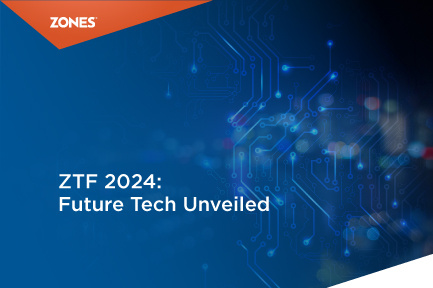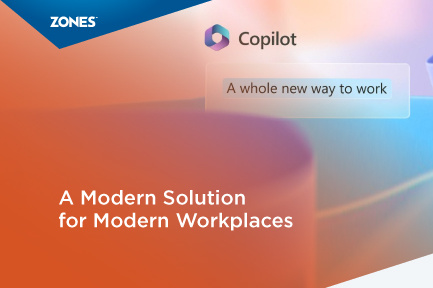ZTF 2024: Exploring Future Innovations in Technology and Business Strategy
According to recent surveys, 70% of businesses plan to achieve end-to-end adoption of next-gen technologies over the next five years. At the Zones...
5 min read
Rajiv Rao : Jun 19, 2024 1:56:24 PM
.jpg)
With the advancing cyber threats, it has become even more critical that organizations have the correct security model to safeguard against them.
The National Institute of Standards and Technology (NIST) Cybersecurity Framework (CSF) is central to cybersecurity management. The revised NIST CSF 2.0 provides a more comprehensive framework for preventing cybersecurity threats and allowing organizations to boost their security levels. It also adequately addresses modern threat scenarios, thus supporting their security posture.
This blog focuses on the details of NIST CSF 2.0, what makes NIST 2.0 transformative, highlights its key benefits, and delves into what’s new compared to its predecessors and how Zones Security Services can help when this framework is not easy to plug and play.
Established in 1901, NIST is a key agency in the U.S. Department of Commerce. It develops standards, procedures, and frameworks that enable organizations to guard themselves against cyber threats. In 2014, NIST developed the Cybersecurity Framework, which addresses how a private sector organization in the United States can assess its cybersecurity preparedness and improve its methods of addressing cyber threats.
The initial framework of the NIST CSF quickly became popular due to its flexibility and comprehensive approach, enabling organizations of all sizes and sectors to tailor it to their specific needs. The critical components of the framework—Identify, Protect, Detect, Respond, and Recover—present a strategic management of cybersecurity threats.
NIST CSF 2.0 was developed from previous experiences and the opinions of various stakeholders to counter new and emerging threats. It has several significant updates to improve utility, expand the product's use, and increase productivity.
One of the key differentiators of NIST CSF 2.0 is its emphasis on governance. Recognizing the critical role that leadership plays in cybersecurity, the updated framework includes more detailed guidance on governance practices
Moreover, NIST CSF 2.0 better associates itself with rising technologies and industry trends, including artificial intelligence, cloud computing, and the Internet of Things, so organizations can secure their digital transformation initiatives.
The NIST CSF 2.0 introduces several new elements that enhance its scope and applicability. Key updates include:
The new "Govern" function emphasizes the importance of leadership and supervision in handling cybersecurity threats. It aims to create governance structures, policies, and processes that ensure cybersecurity is integral to organizational decision-making.
The Framework Core now has more categories and subcategories, offering more detailed advice. This helps organizations match their cybersecurity activities with business goals and risk management strategies.
The updated Implementation Tiers provide clearer guidance on advancing through different stages of cybersecurity maturity. This enables organizations to assess their current capabilities and create an improvement plan.
NIST CSF2.0 has provided comprehensive advice on supply chain risk management, recognizing the growing risks of interlinked supply chains. This helps organizations assess the cybersecurity level of their external vendors and partners.
NIST CSF 2.0 aligns better with other frameworks and standards, such as ISO/IEC 27001, COBIT, and GDPR. This helps with easier integration and compliance across various regulatory requirements.
NIST CSF 2.0 addresses the security implications of emerging technologies, including cloud computing, artificial intelligence, and the Internet of Things (IoT). It offers guidance on integrating these technologies into the existing security framework.
Govern: The “Govern” function integrates cybersecurity into organizational leadership and highlights the roles shaping the cybersecurity culture. It involves policymaking, setting roles, and positioning cybersecurity with business goals.
Identify: The "Identify" function helps organizations understand their cybersecurity risks and critical assets. It does so by considering asset management, the business environment, governance, risk assessment, and strategy to make well-informed decisions about cybersecurity.
Protect: The "Protect" function pays special attention to protection while ensuring the delivery of critical services. It includes areas such as access control, data security, maintenance, and protective technologies.
Detect: This includes activities that detect cybersecurity events, such as ongoing surveillance, detection methods, and event assessment, aiding in the timely discovery of any irregularities and incidents.
Respond: Involves response activities and actions that can be taken to deal with any type of cybersecurity incident, including communication planning and analysis of how to reduce and improve the impact and aid recovery from the incident.
Recover: The "Restore" function describes the actions required to bring back services that were affected by cybersecurity incidents, which include recovery planning, improvements, and communication.
Adopting NIST CSF 2.0 offers numerous benefits that can significantly enhance an organization's cybersecurity posture and overall resilience. Here are five key advantages:
NIST CSF 2.0 provides a structured approach to identifying, assessing, and managing cybersecurity risks. This helps organizations prioritize their security efforts based on risk exposure and potential impact.
The updated framework helps organizations meet various regulatory requirements more effectively. By aligning with NIST CSF 2.0, organizations can demonstrate their commitment to cybersecurity and compliance with regulators and stakeholders.
NIST CSF 2.0 enhances an organization’s ability to detect, respond to, and recover from incidents. This ensures organizations to quickly recover from cyber incidents, minimizing downtime and disruption.
Implementing NIST CSF 2.0 can enhance customer, partner, and investor trust. Demonstrating robust cybersecurity practices shows that an organization is serious about protecting sensitive information and maintaining operational continuity.
The emphasis on continuous improvement and governance in NIST CSF 2.0 encourages organizations to adopt a proactive security posture. This helps avoid emerging threats and reduce the likelihood of successful cyberattacks.
At Zones, we understand the complexities of implementing comprehensive cybersecurity frameworks. Our expert team is well versed in NIST CSF 2.0 and can help your organization navigate the intricacies of this framework.
We offer tailored implementation services that align NIST CSF 2.0 with your organization’s unique needs and objectives. Our approach includes thoroughly assessing your current cybersecurity posture, identifying gaps, and developing a strategic plan to achieve compliance and enhance security.
Zones provides ongoing support and training to ensure your team can effectively manage and sustain the framework. Our training programs are designed to empower your staff with the knowledge and skills necessary to maintain compliance and adapt to evolving cybersecurity challenges.
We are thrilled to announce the Zones Technology Forum (ZTF), a virtual conference held on June 20, 2024. This event featured industry leaders and experts who discussed the latest trends and solutions in cybersecurity, networking, cloud, and the digital workplace.
The ZTF is an excellent opportunity for professionals to gain insights into NIST CSF 2.0 and other cutting-edge technologies. Our sessions covered various topics, providing valuable knowledge and practical advice to help you enhance your organization’s cybersecurity posture.
Don't miss the opportunity to enhance your cybersecurity knowledge. Register now for the Zones Technology Forum to access on-demand sessions, including an insightful presentation on NIST CSF 2.0 by Zones security expert Eric Haberkamp, as well as sessions on networking, cloud, and the digital workplace. Learn from the best and stay ahead in the rapidly evolving world of cybersecurity.
Register Here to watch the on-demand sessions.
With the support of Zones Security Services and the insights gained from the Zones Technology Forum, your organization will be well equipped to navigate the complexities of modern cybersecurity. Register today and take the first step toward a more secure future.
NIST CSF 2.0 is the updated version of the National Institute of Standards and Technology Cybersecurity Framework. It provides comprehensive guidelines for managing and reducing cybersecurity risks.
NIST CSF 2.0 includes new elements such as the "Govern" function for enhanced leadership involvement, better alignment with global standards, expanded categories, improved implementation tiers, and guidance on securing emerging technologies.
Adopting NIST CSF 2.0 enhances risk management, compliance, flexibility, and stakeholder confidence and promotes a proactive security posture by encouraging continuous improvement.
Zones offers tailored implementation services, continuous support, and training to align NIST CSF 2.0 with your organization’s needs, ensuring compliance and improved cybersecurity posture.
The Zones Technology Forum is a virtual conference bringing together industry experts to discuss the latest trends in cybersecurity, networking, cloud, and the digital workplace. It provides valuable insights into NIST CSF 2.0 and other cutting-edge technologies.


According to recent surveys, 70% of businesses plan to achieve end-to-end adoption of next-gen technologies over the next five years. At the Zones...

Recently, the workplace concept has expanded to include physical spaces and digital environments where technology intersects with daily operations....
1 min read
Unified solution offers on-demand cloud provisioning and automation On August 10, at the Zones CustomerConnect business conference, Zones debuted its...